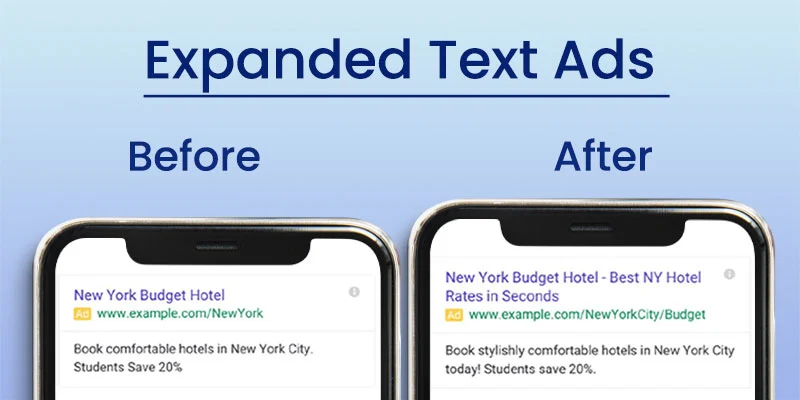
Expanded Text Ads vs Responsive Search Ads: An Overview
Every so often, the change is constant in digital marketing and search engine algorithms to provide users with a better experience and innovations. In Google Ads, this is nothing new. The mobile-first revolution led to the first and major change in search ads, and the introduction of adaptation of machine learning has led to further innovation in Google search ad formats.
Google announced a major update on the Google Ads search campaign to provide customers with a measurable Ads experience and stay up to date with customer expectations. Notably, Responsive Search Ads (RSA) replaced Expanded Text Ads (ETA) in Google Ads.
Here we evaluate this major change and take an in-depth look at the difference between Expanded Text Ads vs Responsive Search Ads steps to create responsive ads for your Google Search Ad campaign.

A Look at the update: Responsive Ads
When it comes to identifying the comprehensive headlines and descriptions for your Google Ad campaign, you have only had two ways; one is to create individual ads and test them accordingly, and another one is to try out responsive search ads; since Google launched in 2018 until then, expanded text ads rolled out as the reign over Google Ads.
However, now responsive ads are the default ad type for Google search campaigns (let’s look at the reason and difference between expanded text ads vs responsive search ads later). In addition, Google gradually leverages new updates that favor automation, making Google Ads more complicated and quite hard to understand when using different formats in Google search ads. But you can’t be able to use, access or edit the expanded text ads from June 30, 2022. However, what does this mean for advertisers? Less effort and maximum results? Let’s see.
What Exactly the Responsive Search Ads?
Responsive ads are Google’s most flexible search ad format. Unlike traditional search ads of crafting headlines and descriptions to create a static search ad, responsive ads allow you to craft 15 different headlines and 4 different descriptions for your search ad campaign. Moreover, collectively those headlines and descriptions can be arranged in 43680 different permutations. As a result, there is an endless ad testing possibility. Definitely, the most robust format of search ads also, can be one of the major differences between the expanded text ads vs responsive search ads.
Google will automatically test different combinations based on your headlines and descriptions input and learn which combination works best. Over time, your responsive search ads will serve the best to different searchers depending on the keyword, device they use, previous browsing history and other signals.
Are Responsive Search Ads Worth It

Implementing responsive ads will create questions like will responsive search ads pay off? Can I reach more customers by using responsive ads? Well, these questions will remain room for discussion. But generally, responsive ads could impact your ad campaign positively and enhance performance to reach further. With strength and customized content, responsive ads will show up more in searchers, resulting in higher engagement in terms of clicks and conversions.
Also, it’s important to keep in mind that your campaign structure plays an imperative role in responsive ads. The performance of your campaign is entirely based on the granular structure of your campaign. The performance result of your campaign may look completely different based on less campaign structure.
What’s the Difference Between Expanded Text Ads vs Responsive Search Ads

Responsive search ads were the second major change in search ad format (expanded ads are the first) after standard text ads when Google Ads was previously called Google AdWords. Let’s look back quickly to know the exact difference between the new update: expanded text ads vs responsive search ads.
The first and original search ad format is known as standard text ads. Standard text ads were used back when Google Ads were known as Google AdWords. The text ads in Google AdWords contained one headline with 30 characters and two descriptions with 35 characters.
Expanded Text Ads

On the other hand, expanded text ads replaced standard text ads in 2016 by Google to enhance the ad experience by more control over your ads and previewing the complete ad of how it’s going to be displayed. You can pick and choose the text assets to place in the headlines and descriptions in the search ad. Moreover, text in your ad doesn’t need to be combinable as in the case of responsive ads.
Back in 2018, Google enriched the expanded text ads to accommodate up to 3 headlines and 2 descriptions. With this enrichment, the space available to create the text for search ads is doubled. This expanded ad enrichment happened roughly at the time as responsive ads entered the stage.
The major difference between expanded text ads vs responsive ads is, in setup number of headlines for expanded ads is up to 3 (30 characters), for responsive ads are up to 15 (30 characters each), and the number of descriptions in setup up to 2 (90 characters each) and up to 4 descriptions in responsive ads (90 characters each). There is no change in headlines and descriptions shown for each format. The maximum length of the headline shown in ads is 150 characters for expanded ads and 300 characters for responsive ads. And the major difference between the two formats is the asset arrangement; in expanded ads, it’s static (as written down), and in responsive search ads, it automatically arranges your text assets.
Benefits of Responsive Ads

The benefits of responsive ads in search campaigns are definitely huge to enhance the ad experience for customers, but how about marketers? Let’s see the benefits of the new search ad format as the responsive search ads examples. If you create an ad campaign in the responsive ad format, it offers more flexibility in means of text creation and testing capabilities. Due to Google’s algorithms, there is not enough time for digital advertisers to test ad copies that are more targeted to potential customers. So, your ads are shown up in the more searchers, potentially attracting more clicks that could lead to conversions, finally, better performance within reach.
Bottom Line
Nowadays, the online advertising universe is more complex and also offers various opportunities to promote products or services. In that case, Google always plays an active role in introducing new features and updates favoring automation. But it is really great to include automation that can reduce your manual efforts and allocate resources where you want to be. As a result, you can focus more on strategy and dedicate time to focus on your campaign performance and results.
Even though implementing the right strategy for your PPC campaigns is more crucial than describing automation in the first place. Because the performance of the campaign depends on many factors, including campaign type, campaign structure, ongoing trends, and the marketing dollars invested in it, if you consider the factors involved in the campaign performance, a PPC agency like InfinityHub can help to create an ad campaign that brings in more qualified leads without any concerns about new algorithm updates (that’s up to us) on your search ad campaign.
Popular Searches
Get Free Quote
Facebook
Twitter
LinkedIn
WhatsApp

 India
India USA
USA


